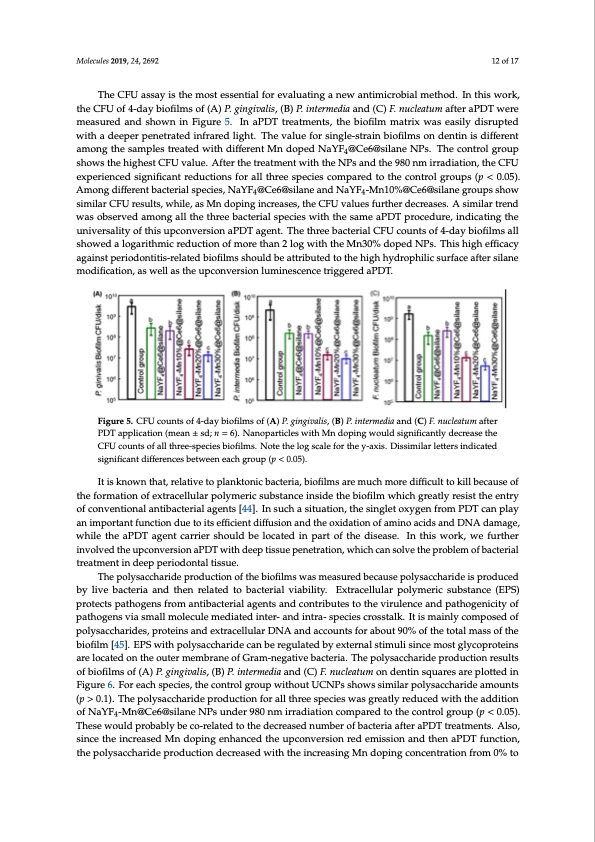
PDF Publication Title:
Text from PDF Page: 012
Molecules 2019, 24, 2692 12 of 17 The CFU assay is the most essential for evaluating a new antimicrobial method. In this work, the CFU of 4-day biofilms of (A) P. gingivalis, (B) P. intermedia and (C) F. nucleatum after aPDT were measured and shown in Figure 5. In aPDT treatments, the biofilm matrix was easily disrupted with a deeper penetrated infrared light. The value for single-strain biofilms on dentin is different among the samples treated with different Mn doped NaYF4@Ce6@silane NPs. The control group shows the highest CFU value. After the treatment with the NPs and the 980 nm irradiation, the CFU experienced significant reductions for all three species compared to the control groups (p < 0.05). Among different bacterial species, NaYF4@Ce6@silane and NaYF4-Mn10%@Ce6@silane groups show similar CFU results, while, as Mn doping increases, the CFU values further decreases. A similar trend was observed among all the three bacterial species with the same aPDT procedure, indicating the universality of this upconversion aPDT agent. The three bacterial CFU counts of 4-day biofilms all showed a logarithmic reduction of more than 2 log with the Mn30% doped NPs. This high efficacy against periodontitis-related biofilms should be attributed to the high hydrophilic surface after silane modification, as well as the upconversion luminescence triggered aPDT. Figure 5. CFU counts of 4-day biofilms of (A) P. gingivalis, (B) P. intermedia and (C) F. nucleatum after PDT application (mean ± sd; n = 6). Nanoparticles with Mn doping would significantly decrease the CFU counts of all three-species biofilms. Note the log scale for the y-axis. Dissimilar letters indicated significant differences between each group (p < 0.05). It is known that, relative to planktonic bacteria, biofilms are much more difficult to kill because of the formation of extracellular polymeric substance inside the biofilm which greatly resist the entry of conventional antibacterial agents [44]. In such a situation, the singlet oxygen from PDT can play an important function due to its efficient diffusion and the oxidation of amino acids and DNA damage, while the aPDT agent carrier should be located in part of the disease. In this work, we further involved the upconversion aPDT with deep tissue penetration, which can solve the problem of bacterial treatment in deep periodontal tissue. The polysaccharide production of the biofilms was measured because polysaccharide is produced by live bacteria and then related to bacterial viability. Extracellular polymeric substance (EPS) protects pathogens from antibacterial agents and contributes to the virulence and pathogenicity of pathogens via small molecule mediated inter- and intra- species crosstalk. It is mainly composed of polysaccharides, proteins and extracellular DNA and accounts for about 90% of the total mass of the biofilm [45]. EPS with polysaccharide can be regulated by external stimuli since most glycoproteins are located on the outer membrane of Gram-negative bacteria. The polysaccharide production results of biofilms of (A) P. gingivalis, (B) P. intermedia and (C) F. nucleatum on dentin squares are plotted in Figure 6. For each species, the control group without UCNPs shows similar polysaccharide amounts (p > 0.1). The polysaccharide production for all three species was greatly reduced with the addition of NaYF4-Mn@Ce6@silane NPs under 980 nm irradiation compared to the control group (p < 0.05). These would probably be co-related to the decreased number of bacteria after aPDT treatments. Also, since the increased Mn doping enhanced the upconversion red emission and then aPDT function, the polysaccharide production decreased with the increasing Mn doping concentration from 0% toPDF Image | Anti-Biofilm Property of Bioactive Upconversion Nanocomposites

PDF Search Title:
Anti-Biofilm Property of Bioactive Upconversion NanocompositesOriginal File Name Searched:
molecules-24-02692.pdfDIY PDF Search: Google It | Yahoo | Bing
Cruise Ship Reviews | Luxury Resort | Jet | Yacht | and Travel Tech More Info
Cruising Review Topics and Articles More Info
Software based on Filemaker for the travel industry More Info
The Burgenstock Resort: Reviews on CruisingReview website... More Info
Resort Reviews: World Class resorts... More Info
The Riffelalp Resort: Reviews on CruisingReview website... More Info
| CONTACT TEL: 608-238-6001 Email: greg@cruisingreview.com | RSS | AMP |